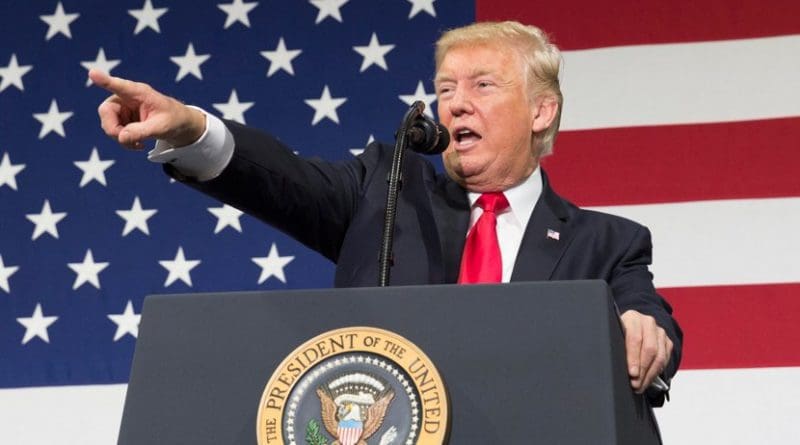The Assassination Of Iran’s Soleimani: Victory For Trump, Failure For The US? – Analysis
By IPCS
By Pieter-Jan Dockx*
On 3 January, a US drone strike near Baghdad airport killed Major General Qasem Soleimani of Iran’s Islamic Revolutionary Guard Corps (IRGC) as well as his main Iraqi ally, militia leader Abu Mahdi al-Muhandis. The assassinations are the latest escalation of a series of tit-for-tat attacks between the US and Iran’s allies in Iraq. They come close on the heels of the storming of the US Embassy in Baghdad by pro-Iranian protesters on 31 December. While the killings mark a significant victory for US President Donald Trump in his confrontation with Iran, they risk a further erosion of US influence in the region.
Victory Over Iran
Soleimani’s assassination is a major landmark in President Trump’s efforts to contain Iran’s influence in West Asia.
As the head of the IRGC’s external operations, Soleimani was the key strategist of Iran’s regional expansion through a network of loyal militias. He also held extensive influence over Tehran’s foreign policy in the region. This became most overt in February 2019 when Iran’s Foreign Minister, Javad Zarif, briefly resigned because of Soleimani’s outsized influence over Iran’s Syria policy.
By killing al-Muhandis, the US has also disrupted Iran’s relationship with Iraq’s Popular Mobilisation Forces (PMF)—a collective of predominantly Shia militias with varying degrees of affinity to Tehran. Muhandis was the PMF’s deputy commander and operated as the de-facto leader of the umbrella organisation. He was also considered one of Tehran’s most loyal actors in Iraq. Although his likely successor, Hadi al-Amiri, is also seen as an Iranian proxy; his politics are considered less ideological and more pragmatic than Muhandis’.
Furthermore, the drone strikes also address a crucial flaw in Trump’s policy of “maximum pressure” on Iran—his perceived reluctance to use military means. Since pulling out of the Iran nuclear deal in May 2018, the US president has mostly relied on economic sanctions to contain Iran. Despite the inefficacy of these sanctions, it was widely believed that Trump would refrain from resorting to direct military action—a belief also held in Tehran. By assassinating Soleimani, Trump has added a hard power dimension to “maximum pressure;” bolstering US’ bargaining position vis-à-vis Iran.
Trump’s readiness to use hard power is also the main reason why a full-blown war is unlikely to take place, with Tehran opting for restraint instead. While neither the US nor Iran could win a conventional war, direct military action by the US against Iran could threaten the survival of the current regime. The pre-eminence of regime survival for Tehran is likely to deter them from risking further escalation that could result in a direct military confrontation. Instead, Iran’s response will be indirect and asymmetric; through the use of regional proxies, drone strikes, and cyber attacks.
A Blow to US’ Regional Influence
Despite the success of the assassinations in terms of containing Iran, it is likely to undermine Washington’s partnerships and influence in the region.
An escalation in tension with Iran is not in the interest of the US’ Arab allies. Saudi Arabia and the UAE are rumoured to have held private talks with Tehran to de-escalate tensions in the Gulf. Since the drone strikes on its oil facilities in September 2018, Riyadh has also attempted to ease its disputes with Yemen’s Houthis and Qatar—both considered to be close to Iran. Trump’s actions could undermine these attempts at reconciliation, making its allies viable targets for Iranian retaliation instead.
Moreover, the assassinations once more highlight the unpredictability of Washington’s policies in the region, making it harder for its allies to rely on the US. Trump’s decision to kill an Iranian general was an unexpected and disproportionate escalation of the dispute. This is reminiscent of earlier abrupt policy decisions like the recognition of Israel’s annexation of the Golan Heights, and ending the support for US’ Kurdish allies in Syria. Because of this increasing volatility, US allies in the Gulf will gradually look for more stable partners like Russia, thus reducing Washington’s clout in the region.
The US also stands to lose influence in Iraq as the attacks threaten the continued presence of approximately 5,000 US troops stationed in the country. The assassinations were not only a violation of Iraq’s sovereignty but also a direct attack on the Iraqi state—of which Muhandis was an official member. Pressure from nationalists and Iranian proxies will force the Iraqi government to revise the US’ military presence in the country.
The drone strikes against Soleimani marks a pivotal moment for Trump’s strategy of “maximum pressure” on Iran. Policymakers in Tehran are now faced with an unpredictable US president willing to resort to military action. Yet, it is also this unpredictability that has once more been brought to the attention of leaders in Gulf capitals—further damaging the US’ reliability as an ally. As Washington’s West Asia policy is being reduced to an Iran policy, Trump’s actions will impact not only Iran but also US’ future in the region.
*Pieter-jan Dockx, Researcher, Centre for Internal and Regional Security (IReS)


Soleimani was killing too many of our proxy army’s troops.